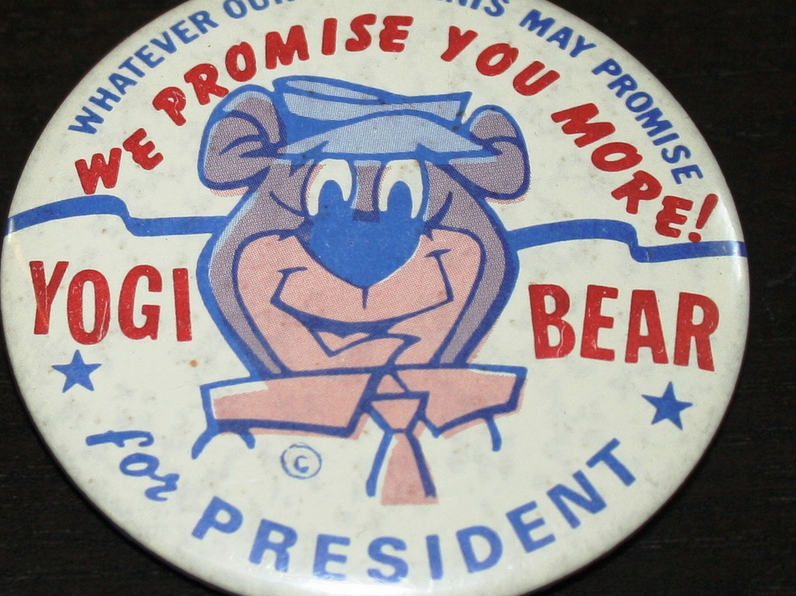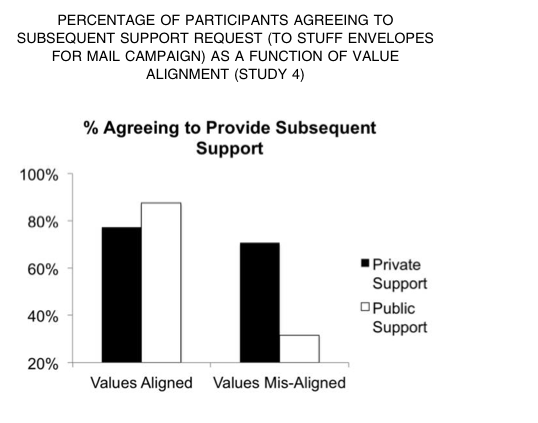Easy Public Displays Of Support For Charities Lead To Slacktivism

Sure, you wear the button that says you want a basket-thieving bear for President, but are you really willing to donate your time or money to the cause? (photo: bluwmongoose)
The report, published in the Journal of Consumer Research by researchers at the University of British Columbia Sauder School of Business, performed various tests to see if public support for a cause had any correlation to his/her likelihood of donating time or money to that cause.
Test #1
The first test involved Remembrance Day, the day on which Canadians commemorate those who fought and died in World War I. It’s common on this day to wear a poppy while out and about. Researchers looked at 91 college students who were not wearing poppies while entering the school’s student union building.
These students were divided into three groups. The first group was approached and offered a poppy that they could wear then and there. The second group were offered poppies in envelopes that they could later choose to wear or do with as they please. The third group did not receive any offer of a free poppy.
A short while later, each of the people who willingly took a poppy (or who were in the third group) was asked “Would you like to make a donation to support Canada’s veterans?”
The results showed that those who had received the poppies in a private manner (i.e., in the envelope) donated an average amount that was more than twice that of those that received poppies publicly, and nearly six times that of those who were not offered the flower.
The researchers believe that this is because those who agreed to wear the poppy may feel like they have already done their part to support the cause, while those who received the flower privately are now aware of the issue but have not yet made a public show of support.
Test #2
This second test is a bit more complicated. Researchers showed groups of college students two different causes that were in need of support. One group was given the option of publicly signing a petition for either of the causes, while members of another group was asked to fill out an individual ballot and place it in a sealed box. A third group was only asked to sign attendance sheets showing that they had read about the charities. Other groups were randomly asked to read about either of the causes but not asked to sign a petition or provide any other form of token support.
Around 45 minutes to an hour later, students were told that whichever cause they had chosen to support needed volunteers to help stuffing envelopes for a letter-writing campaign. Participants were then asked how much time, between 0-150 minutes, they would be willing to volunteer.
Once again, those whose support of the charity had been done in a private manner were significantly more willing to give of their time, averaging nearly an hour of envelope-stuffing compared to around 30 minutes on average for those who had signed the petition in public. The groups that were not asked to provide token support for either group had similar results to those participants who signed petitions in public.
“Taken together, the results of studies 1 and 2 provide support for the notion that an initial act of public token support is no more effective than no initial act of support, and less effective than a private act of token support, in motivating meaningful contributions to a cause,” write the researchers.
Test #3
This test effectively repeats the second, but takes away the time variable when it came time to volunteer for one of the causes. Rather than ask participants how many minutes they would volunteer for the cause they supported, the researchers simply asked a yes or no “Would you volunteer to help stuff envelopes for 60 minutes?”
And again, those who had been asked to show their support for a cause in private were significantly more likely than those who had been asked to express their support in a public petition (78% to 59%), and those who had not been asked to show any support via petition showed basically the same positive response as those who had done so publicly.
Test #4
“[C]onsumers have multiple avenues open to them to engage in very public forms of token support… in ways that are relatively easy and costless,” write the researchers, giving ribbons, bumper stickers, and Facebook likes as examples. “One question that arises, then, is whether a way exists to overcome the tendency to withhold more meaningful contributions to the cause following an initial act of public support.”
The fourth test takes the two charities used in the previous two tests and moves them to Facebook. Student participants were asked to log on to Facebook using their personal accounts, and then choose which of the two organizations’ Facebook groups they wanted to join.
Researchers set up the test so that for some participants, the groups they were joining were public (i.e., that their joining of these groups would show up in the users’ timelines for friends to see) while for others the charities’ groups were made private (i.e., the user knows he has joined the group but this information is not shared on the timeline). These latter participants were also notified that their joining of the charity’s Facebook group was not being made public.
The participants were then asked a series of questions to determine how well they believed their personal values aligned with the values of the charities whose Facebook group they joined. Finally, they were asked the yes/no question about whether they would help stuff envelopes for the group they had chosen to support.
Interestingly, when a participant’s values are the same as those of the charity he supports and that charity’s Facebook group is public, he is just as likely, if not more so, to donate his envelope-stuffing time to that charity. This is the one instance in the report in which a private token show of support did not result in a higher likelihood of participants agreeing to provide a more substantial form of support for the charity.
That said, when the participant’s values do not align with the selected charity, there is once again a mammoth difference in willingness to stuff envelopes between those who joined the group privately and those who did so publicly:
“The results of study 4 highlight how charitable organizations can use value alignment to combat slacktivism,” write the researchers, “turning initial acts of public token support into more meaningful subsequent support. We show that by focusing those who engage in an initial act of token support in public on the value alignment between self and cause, we can increase helping on a subsequent, more meaningful task.”
One thing this report does not get into is the psychology of those who choose to loudly trumpet their support of a cause in very public venues and whether those same people are more or less likely to also be making substantial contributions.
The results do, however, seem to indicate that the average consumer, perhaps subconsciously, feels that making some sort of public statement for a cause — whether it’s a ribbon, a flower, a bumper sticker, signing a petition or sharing a Facebook like — may alleviate them of any obligation for further, more substantial support.
Want more consumer news? Visit our parent organization, Consumer Reports, for the latest on scams, recalls, and other consumer issues.


